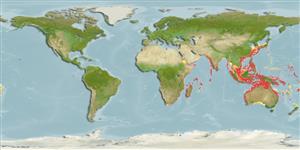>
Aulopiformes (Grinners) >
Synodontidae (Lizardfishes) > Synodontinae
Etymology: Synodus: Greek, syn, symphysis = grown together + Greek, odous = teeth (Ref. 45335).
More on author: Day.
Environment: milieu / climate zone / depth range / distribution range
Ökologie
seewasser riff-verbunden; tiefenbereich 20 - 100 m (Ref. 9710). Tropical
Indo-West Pacific: southern Red Sea and East Africa (Ref. 4055) to southern India and Sri Lanka. One specimen is known from the Philippines. Also reported from Indonesia and northwestern Australia (Ref. 5978).
Size / Gewicht / Alter
Maturity: Lm ? range ? - ? cm
Max length : 33.0 cm TL Männchen/unbestimmt; (Ref. 11228); common length : 12.0 cm TL Männchen/unbestimmt; (Ref. 3520)
Rückenflossenstacheln (insgesamt): 0; Rückenflossenweichstrahlen (insgesamt): 11-13; Afterflossenstacheln 0; Afterflossenweichstrahlen: 9 - 11. Body dusky pink above, with pale blue-grey blotches and stripes; 2 black streaks at upper edge of operculum; caudal fin yellow in color; some with dark blotches along lateral line (Ref. 11228).
Found on current-prone (Ref. 48635) sand or mud bottoms (Ref. 11228), usually in depths of 20 m or more. Usually buries itself in the sand (Ref. 48635). Sold fresh and dried salted in markets.
Life cycle and mating behavior
Geschlechtsreife | Fortpflanzung | Ablaichen | Eier | Fecundity | Larven
Cressey, R.F. and R.S. Waples, 1984. Synodontidae. In W. Fischer and G. Bianchi (eds.) FAO species identification sheets for fishery purposes. Western Indian Ocean (Fishing Area 51). Volume 4. FAO, Rome. (Ref. 3520)
IUCN Rote Liste Status (Ref. 130435)
Bedrohung für Menschen
Harmless
Nutzung durch Menschen
Fischereien: kommerziell
Mehr Information
NamenSynonymeMetabolismusRäuberÖkotoxikologieFortpflanzungGeschlechtsreifeAblaichenSpawning aggregationFecundityEierEientwicklung
ReferenzenAquakulturAquakultur ProfilZuchtlinienGenetikElectrophoresesVererbbarkeitKrankheitenVerarbeitungNutrientsMass conversion
Tools
Zusatzinformationen
Download XML
Internet Quellen
Estimates based on models
Preferred temperature (Ref.
123201): 21.9 - 28.3, mean 27.2 °C (based on 503 cells).
Phylogenetic diversity index (Ref.
82804): PD
50 = 0.5000 [Uniqueness, from 0.5 = low to 2.0 = high].
Bayesian length-weight: a=0.00468 (0.00277 - 0.00790), b=3.21 (3.06 - 3.36), in cm total length, based on LWR estimates for this species & Genus-body shape (Ref.
93245).
Trophic level (Ref.
69278): 4.2 ±0.7 se; based on size and trophs of closest relatives
Widerstandsfähigkeit (Ref.
120179): hoch, Verdopplung der Population dauert weniger als 15 Monate. (Preliminary K or Fecundity.).
Fishing Vulnerability (Ref.
59153): Low vulnerability (23 of 100).
Nutrients (Ref.
124155): Calcium = 50.8 [18.1, 104.8] mg/100g; Iron = 0.51 [0.18, 1.13] mg/100g; Protein = 15.9 [13.0, 18.3] %; Omega3 = 0.0664 [, ] g/100g; Selenium = 35.9 [14.3, 82.5] μg/100g; VitaminA = 103 [26, 338] μg/100g; Zinc = 0.871 [0.497, 1.328] mg/100g (wet weight);
